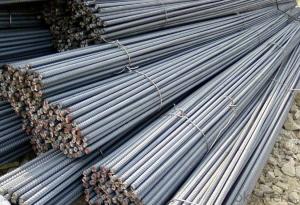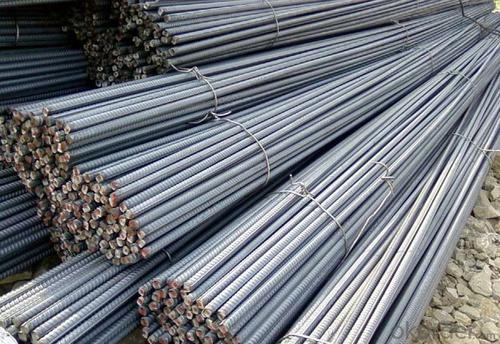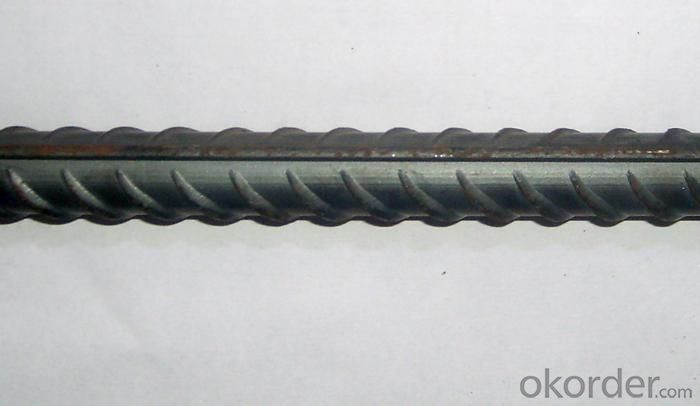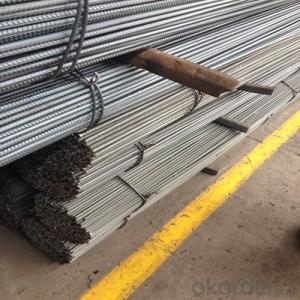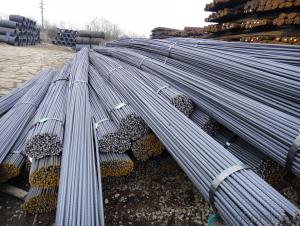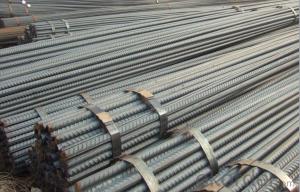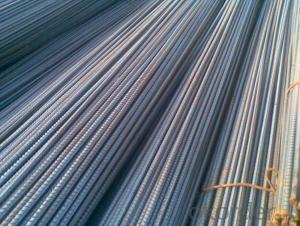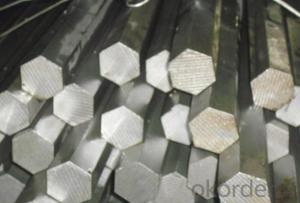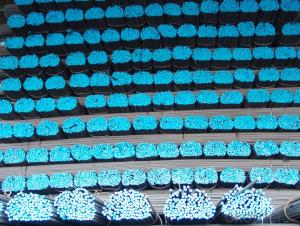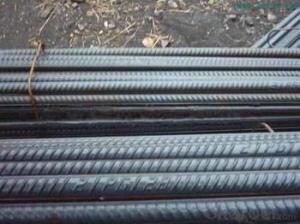Hot Rolled Carbon Steel Deformed Bar 28mm with High Quality
- Loading Port:
- China Main Port
- Payment Terms:
- TT or LC
- Min Order Qty:
- 25 m.t.
- Supply Capability:
- 30000 m.t./month
OKorder Service Pledge
OKorder Financial Service
You Might Also Like
Product Description:
OKorder is offering Hot Rolled Carbon Steel Deformed Bar 28mm with High Quality at great prices with worldwide shipping. Our supplier is a world-class manufacturer of steel, with our products utilized the world over. OKorder annually supplies products to European, North American and Asian markets. We provide quotations within 24 hours of receiving an inquiry and guarantee competitive prices.
Product Applications:
Hot Rolled Carbon Steel Deformed Bar 28mm with High Quality is widely used in buildings, bridges, roads and other engineering construction. Big to highways, railways, bridges, culverts, tunnels, public facilities such as flood control, dam, small to housing construction, beam, column, wall and the foundation of the plate, deformed bar is an integral structure material. With the development of world economy and the vigorous development of infrastructure construction, real estate, the demand for deformed bar will be larger and larger..
Product Advantages:
OKorder's Hot Rolled Carbon Steel Deformed Bar 28mm with High Quality are durable, strong.packed and suitable for construction
Main Product Features:
· Premium quality
· Prompt delivery & seaworthy packing (30 days after receiving deposit)
· Can be recycled and reused
· Mill test certification
· Professional Service
· Competitive pricing
Product Specifications:
Manufacture: Hot rolled
Grade: HRB335 HRB400 BS4449 Grade460 ASTM Grade40 Grade60
Certificates: ISO, SGS, BV, CIQ
Length:6m 8m 9m 12m
Packaging: Export packing, packed by coil
FAQ:
Q1: Why buy Materials & Equipment from OKorder.com?
A1: All products offered byOKorder.com are carefully selected from China's most reliable manufacturing enterprises. Through its ISO certifications, OKorder.com adheres to the highest standards and a commitment to supply chain safety and customer satisfaction.
Q2: How do we guarantee the quality of our products?
A2: We have established an advanced quality management system which conducts strict quality tests at every step, from raw materials to the final product. At the same time, we provide extensive follow-up service assurances as required.
Q3: How soon can we receive the product after purchase?
A3: Within three days of placing an order, we will begin production. The specific shipping date is dependent upon international and government factors, but is typically 7 to 10 workdays.
Q4: How many tons per bundle?
A4: Around 2-3tons
Q5: How to avoid the rust after deliver the goods to the loading port?
A5: We will keep the goods at the port covered with water-proof material
Q6: What is the chemical composition and physical properties of HRB400?
A6:
Grade | Technical data of the original chemical composition (%) | ||||||
C | Mn | Si | S | P | V | ||
HRB400 | ≤0.25 | ≤1.60 | ≤0.80 | ≤0.045 | ≤0.045 | 0.04-0.12 | |
Physical capability | |||||||
Yield Strength (N/cm²) | Tensile Strength (N/cm²) | Elongation (%) | |||||
≥400 | ≥570 | ≥14 | |||||
Q7:What is chemical composition and physical properties of 500B?
A7:
BS4449 500B | Chemical Composition(%) | ||||
C | Mn | Si | S | P | |
≤0.24 | ≤0.45 | ≤0.16 | ≤0.05 | ≤0.31 | |
Physical capability | |||||
Yield Strength(N/cm²) | Tensile Strength(N/cm²) | Elongation (%) | |||
≥650 | ≥500 | 19 | |||
Q8: What is the chemical composition and physical properties of HRB335?
A8:
HRB335 | Chemical Composition(%) | ||||
C | Mn | Si | S | P | |
≤0.25 | ≤1.60 | ≤0.80 | ≤0.045 | ≤0.045 | |
Physical capability | |||||
Yield Strength(N/cm²) | Tensile Strength(N/cm²) | Elongation (%) | |||
≥335 | ≥490 | ≥16 | |||
Images:
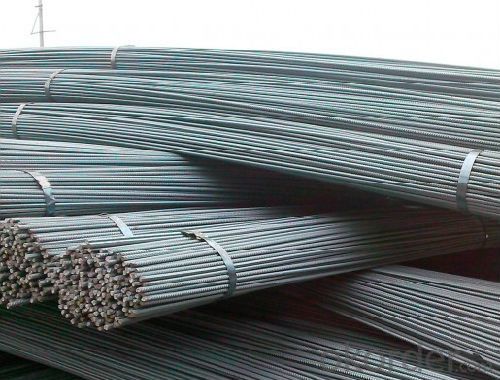
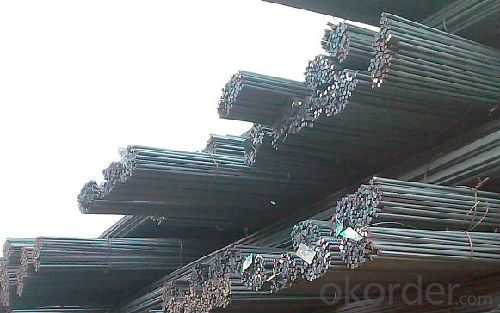
- Q: What does thread steel have to do with scrap steel?
- There is a need to go through the processing of the construction units in the construction process of steel, for example, generally buy spiral steel to the standard 9 meters or 12 meters, the Jianshi needs 2.5 meters long 3.5 meters long and 1.7 meters long, 9 meters long steel eventually left a little cut small head these small head, or sold to a blacksmith shop, or you can only do what he can do, if he can do to the recycling of steel scrap processing.
- Q: Are there any international standards for steel rebars?
- Yes, there are several international standards for steel rebars. The most widely recognized standard is the ISO 6935-2, which provides specifications for steel rebars used in reinforced concrete structures. Additionally, the American Society for Testing and Materials (ASTM) has its own set of standards, such as ASTM A615 and ASTM A706, which are widely adopted in North America and many other countries. Other international standards include the European standard EN 10080 and the British standard BS 4449. These standards ensure quality, strength, and compatibility of steel rebars across different regions.
- Q: How do steel rebars affect the overall lifespan of a structure?
- The overall lifespan of a structure is greatly improved by steel rebars. When added to reinforced concrete, rebars significantly enhance the building's strength, durability, and structural integrity. To begin with, the incorporation of rebars reinforces the concrete, enabling it to withstand heavy loads and stresses. While concrete is strong when compressed, it lacks tensile strength. By including rebars, the concrete gains the ability to resist tension forces, which prevents cracks and failures that could compromise the structure's longevity. Additionally, rebars serve as a protective barrier against corrosion. Concrete is a porous material, and when water and moisture infiltrate its surface, they can reach the embedded steel, leading to rust and subsequent weakening of the structure. However, rebars are made of corrosion-resistant materials, such as stainless steel or epoxy-coated steel, which shield them from corrosion and ensure the structure's longevity. Moreover, rebars improve the overall stability and load-bearing capacity of the structure. By reinforcing critical areas like beams, columns, and the foundation, rebars enhance the structure's ability to withstand seismic forces, wind loads, and other external pressures. This reinforcement significantly reduces the risk of structural failure and extends the structural lifespan. Furthermore, rebars allow for flexibility and adaptability in design. Engineers can customize the reinforcement according to the specific requirements of the structure due to the availability of rebars in various sizes and shapes. This flexibility guarantees that the structure is optimized for maximum strength and durability, ultimately prolonging its lifespan. In conclusion, the inclusion of steel rebars is crucial for increasing the overall lifespan of a structure. Their ability to reinforce concrete, protect against corrosion, enhance stability, and provide design flexibility ensures that the building can endure different loads and environmental conditions. This minimizes the risk of premature failure and guarantees the structure's longevity.
- Q: How do steel rebars resist corrosion?
- Steel rebars resist corrosion through a process called passivation. When the steel is exposed to air and moisture, a thin layer of iron oxide forms on its surface, which acts as a protective barrier against further corrosion. This layer, also known as rust, prevents oxygen and moisture from reaching the inner layers of steel, thereby preventing further oxidation. Additionally, steel rebars are often coated with materials such as epoxy or zinc to provide an extra layer of protection against corrosion. These coatings act as a physical barrier between the steel and the environment, preventing contact with corrosive elements. Regular maintenance, such as cleaning and applying protective coatings, can also help to extend the lifespan of steel rebars and prevent corrosion.
- Q: How are steel rebars affected by long-term exposure to water?
- Steel rebars are prone to corrosion when exposed to water for extended periods of time. The water facilitates the process of oxidation, leading to the formation of rust on the surface of the rebars. This corrosion weakens the integrity of the steel, reducing its load-bearing capacity and overall structural strength. Therefore, long-term exposure to water can significantly deteriorate steel rebars, compromising the durability and safety of structures they are used in.
- Q: What are the different methods of connecting steel rebars together?
- The connection of steel rebars can be achieved through various methods, depending on the specific needs of the construction project. Here are some commonly used techniques: 1. Lap Splicing: This method involves overlapping two rebars and securing them together using steel wire or bars. It is a cost-effective approach, although it requires longer rebars. 2. Mechanical Splicing: By using a mechanical coupler such as a sleeve or collar, two rebars can be connected. This method offers a strong and reliable connection and allows for flexibility in rebar positioning. It is faster and more efficient than lap splicing. 3. Welding: Steel rebars can be connected by heating and fusing their ends together using an electric arc. This creates a permanent and robust connection. However, welding demands skilled labor and can be time-consuming and expensive. 4. Threaded Couplers: Similar to mechanical splicing, this method involves threading the ends of rebars and connecting them using a threaded coupler. It provides a reliable connection and is commonly used in larger construction projects. 5. Grout Sleeve Splicing: This technique incorporates a grout-filled sleeve between two rebars to establish a connection. The grout enhances strength and stability, making it suitable for seismic zones or areas requiring high strength and ductility. 6. Reinforcing Bar Couplers (RBC): RBC is a proprietary method that employs a threaded sleeve filled with epoxy resin to connect rebars. It offers high load capacity, ease of installation, and resistance to corrosion. To determine the most appropriate method for connecting steel rebars in a specific construction project, it is crucial to consult structural engineers and adhere to building codes and regulations.
- Q: What are the safety precautions to be followed while working with steel rebars?
- To prevent accidents and injuries while working with steel rebars, it is essential to adhere to specific safety measures. Consider the following precautions: 1. Personal Protective Equipment (PPE): Ensure that you always wear suitable PPE, including safety glasses, gloves, hard hats, and steel-toed boots. These items will shield you from potential dangers like falling objects, sharp edges, and flying debris. 2. Training and Knowledge: Before handling steel rebars, make sure you have undergone proper training and understand the associated safety protocols. Familiarize yourself with the equipment used and comprehend the potential risks involved. 3. Proper Lifting Techniques: Handling steel rebars can be challenging due to their weight and awkward shape. Always utilize correct lifting techniques, such as bending your knees and using your legs instead of your back. Do not attempt to lift a rebar that exceeds your capacity; seek assistance if necessary. 4. Secure Storage: Store steel rebars in a designated area that is free from potential obstructions. Stack them in a stable manner to prevent toppling and causing injuries. 5. Safe Handling: When moving steel rebars, exercise caution due to their sharp edges and potential for harm. Employ appropriate lifting equipment, such as cranes or forklifts, if required. Avoid dragging or sliding rebars, as this can lead to strains or sprains. 6. Fall Protection: If working at heights or near open edges, ensure that adequate fall protection measures are in place. This may involve using guardrails, safety harnesses, or safety nets to prevent falls. 7. Fire Safety: Steel rebars can become extremely hot when exposed to heat or flames. Ensure that appropriate fire prevention measures are in place, such as fire extinguishers, and exercise caution when working near flammable materials. 8. Communication: Maintain clear communication with colleagues and supervisors to ensure everyone is aware of their surroundings and potential hazards. Utilize hand signals or radios when working in noisy environments. 9. Regular Inspections: Routinely inspect steel rebars for any defects, such as cracks or sharp edges, that could pose a safety risk. Immediately remove any damaged or faulty rebars from use. 10. First Aid and Emergency Procedures: Familiarize yourself with first aid procedures and emergency protocols in the event of accidents or injuries. Have a well-stocked first aid kit readily available on-site and know the location of the nearest medical facility. By adhering to these safety precautions, you can minimize the likelihood of accidents and injuries while working with steel rebars. Always prioritize your safety and the safety of those around you.
- Q: What is the impact of steel rebars on the overall maintenance of a building?
- Steel rebars have a significant impact on the overall maintenance of a building. These reinforcement bars provide structural strength and stability by enhancing the tensile strength of concrete. By preventing cracks and minimizing structural damage, steel rebars reduce the need for frequent repairs and maintenance. Additionally, their corrosion resistance properties enhance the longevity of the building, reducing maintenance costs and ensuring its structural integrity in the long run.
- Q: What are the different types of tests conducted on steel rebars for quality assurance?
- There are several types of tests conducted on steel rebars for quality assurance. Some common tests include tensile testing, bend testing, impact testing, hardness testing, and chemical composition analysis. These tests help ensure that the rebars meet the required mechanical properties, dimensional tolerances, and chemical composition standards, ensuring their quality and suitability for various construction applications.
- Q: How are steel rebars protected from concrete spalling?
- Steel rebars are protected from concrete spalling through the use of two main methods: epoxy coating and concrete cover. Epoxy coating is applied to the rebars to prevent direct contact with the concrete, forming a protective layer that prevents corrosion. Additionally, a sufficient concrete cover is provided around the rebars to shield them from environmental factors and potential damage, ensuring their long-term durability and structural integrity.
Send your message to us
Hot Rolled Carbon Steel Deformed Bar 28mm with High Quality
- Loading Port:
- China Main Port
- Payment Terms:
- TT or LC
- Min Order Qty:
- 25 m.t.
- Supply Capability:
- 30000 m.t./month
OKorder Service Pledge
OKorder Financial Service
Similar products
Hot products
Hot Searches
Related keywords
